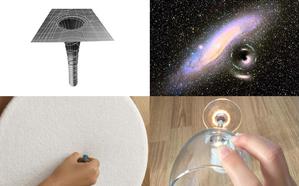Glossary term: Accretion Disk
Description: When an astrophysical object accretes matter, unless the in-falling matter is already moving straight towards the attracting object, it cannot fall directly onto it. Indeed as the in-falling object moves closer to the attracting object, the component of its velocity that is perpendicular to the line between it and the attracting object increases due to conservation of angular momentum.
In many cases, in-falling matter will collect in what is called an accretion disk: a swirling disk of gas and dust surrounding the attracting object. From the inner rim of the disk, matter can fall onto the central object. For a compact central object, matter falling onto the accretion disk will have gained an enormous amount of energy while falling. As this energy is deposited in the disk, the disk can heat up to temperatures of hundreds of thousands or even millions of kelvins. Accretion disks around the supermassive black holes in the center of some galaxies provide the power for active galactic nuclei (AGN). These extremely bright objects can be brighter than all the stars in their host galaxy combined.
Accretion disks are found in a variety of astrophysical situations such as around supermassive black holes, stellar remnants, gamma ray bursts, or protostars.
Related Terms:
- Active Galactic Nucleus
- Black Hole
- Neutron Star
- Protostar
- Stellar Remnants
- Supermassive Black Hole
- Accretion
- Gamma Ray Burst
See this term in other languages
Term and definition status: This term and its definition have been approved by a research astronomer and a teacher
The OAE Multilingual Glossary is a project of the IAU Office of Astronomy for Education (OAE) in collaboration with the IAU Office of Astronomy Outreach (OAO). The terms and definitions were chosen, written and reviewed by a collective effort from the OAE, the OAE Centers and Nodes, the OAE National Astronomy Education Coordinators (NAECs) and other volunteers. You can find a full list of credits here. All glossary terms and their definitions are released under a Creative Commons CC BY-4.0 license and should be credited to "IAU OAE".
If you notice a factual error in this glossary definition then please get in touch.
Related Activities
Hunting for black holes
astroEDU educational activity (links to astroEDU website) Description: How do astronomers detect invisible black holes?
License: CC-BY-4.0 Creative Commons Attribution 4.0 International (CC BY 4.0) icons
Tags:
Model
, Experiment
Age Ranges:
12-14
Education Level:
Informal
, Middle School
Areas of Learning:
Modelling
, Observation based
, Problem-solving
, Social Research
Costs:
Low Cost
Duration:
45 mins
Group Size:
Group
Skills:
Constructing explanations
, Developing and using models









